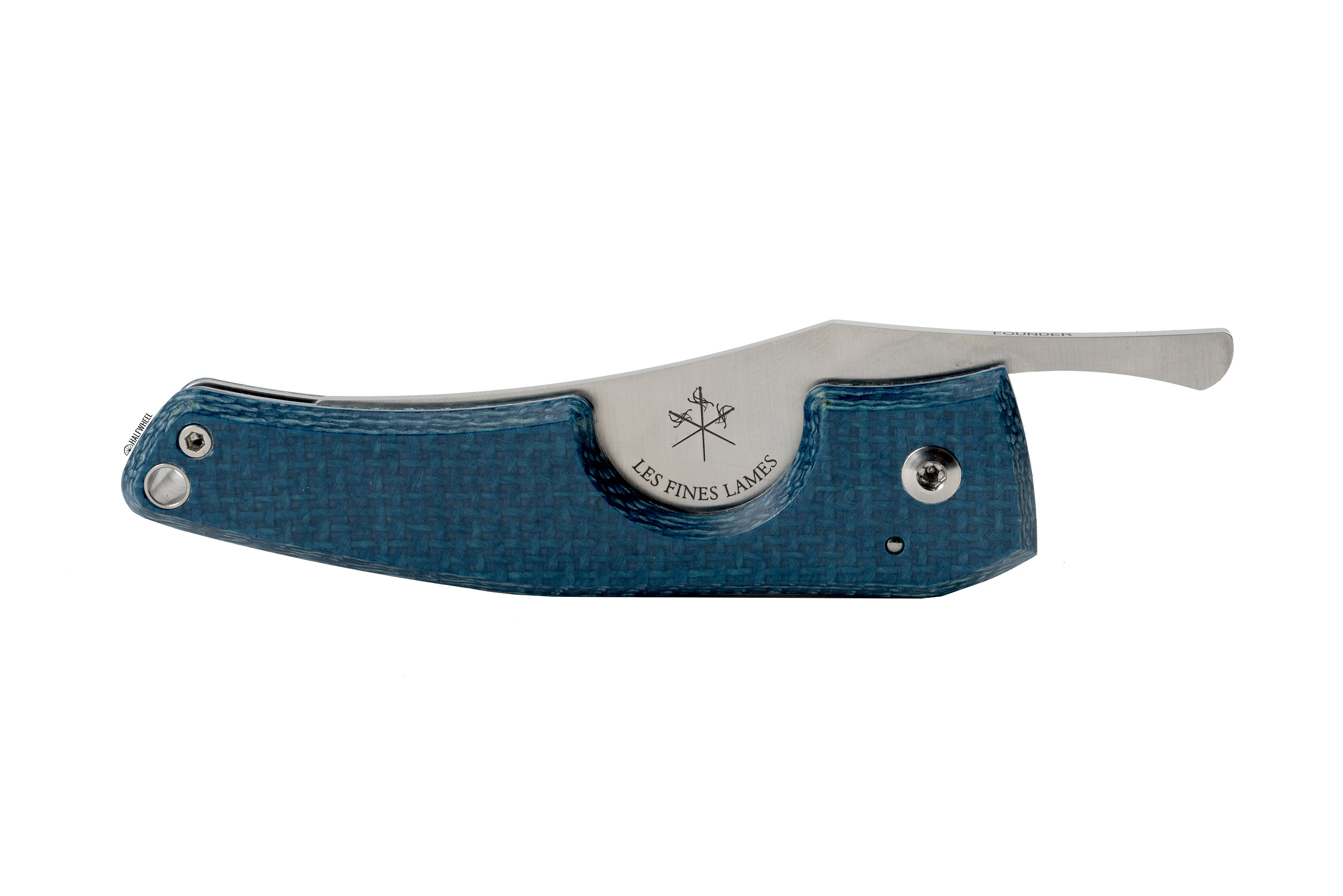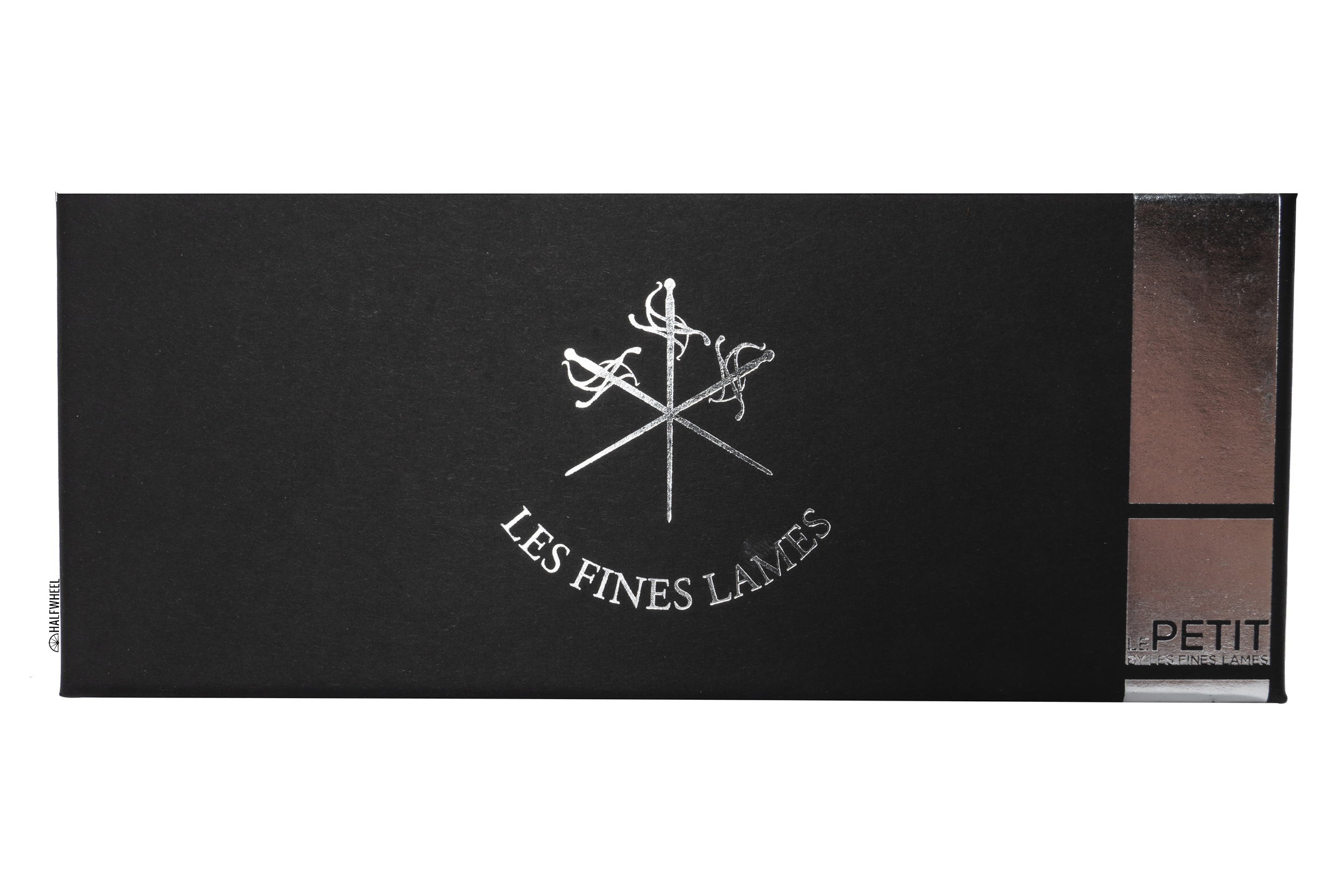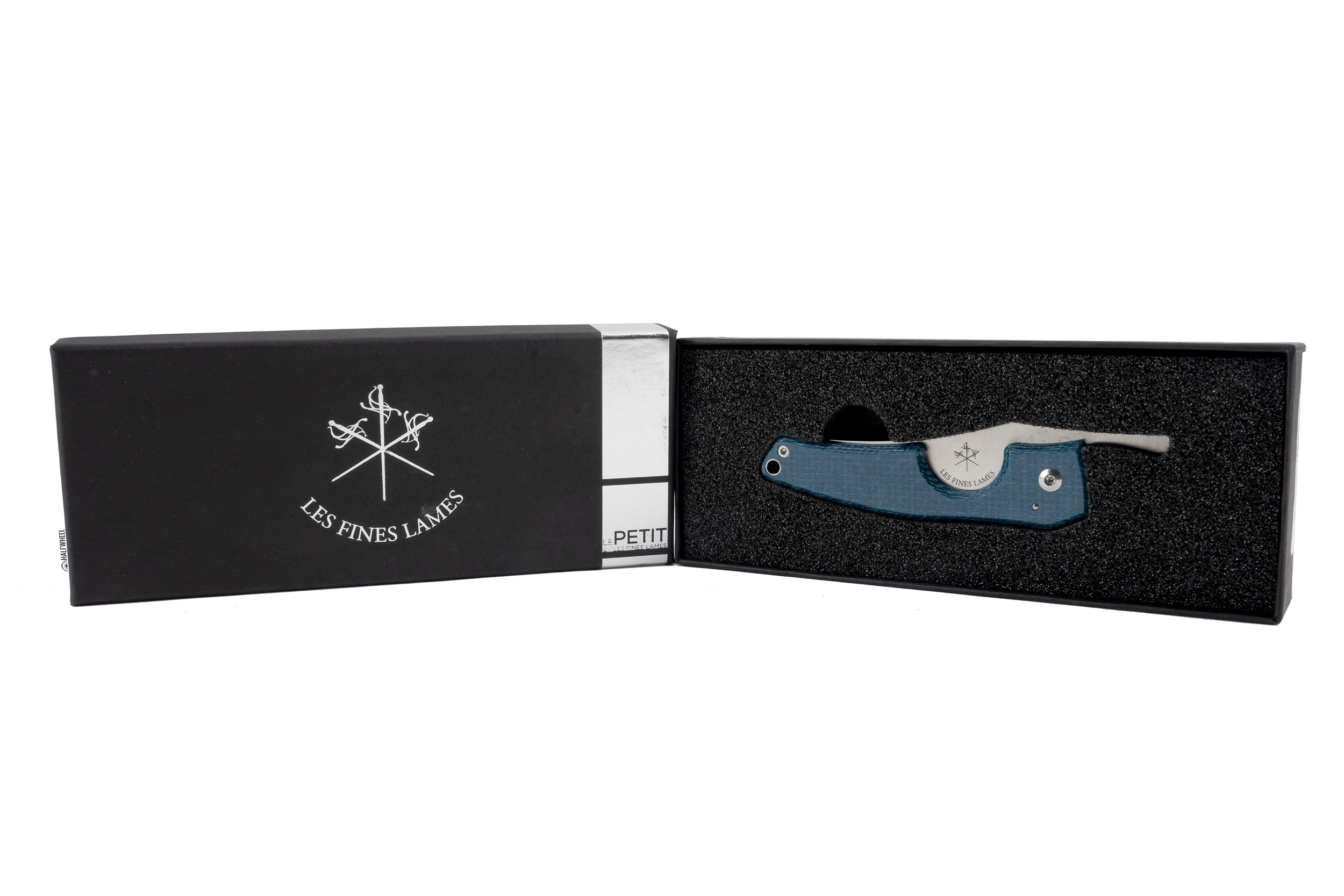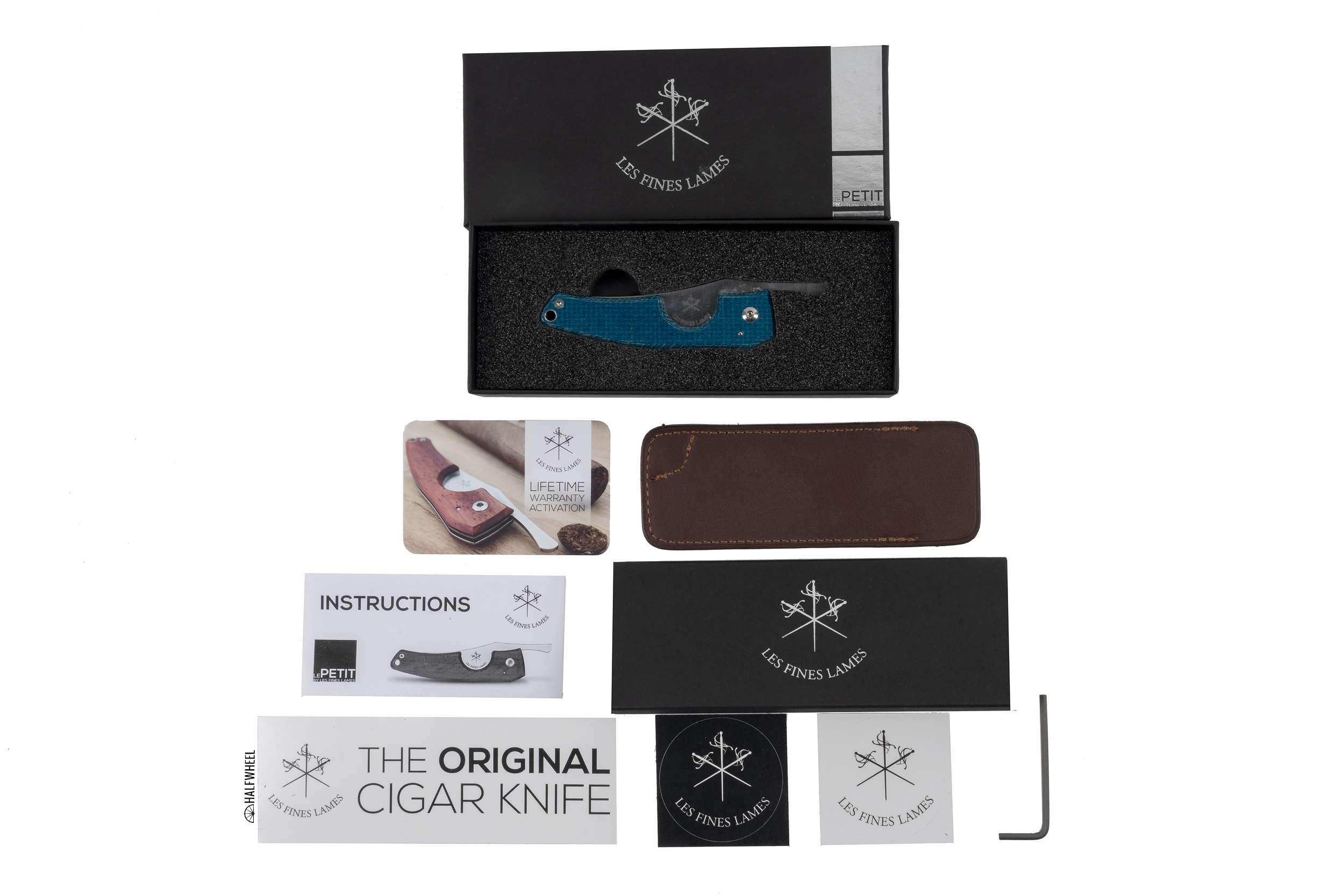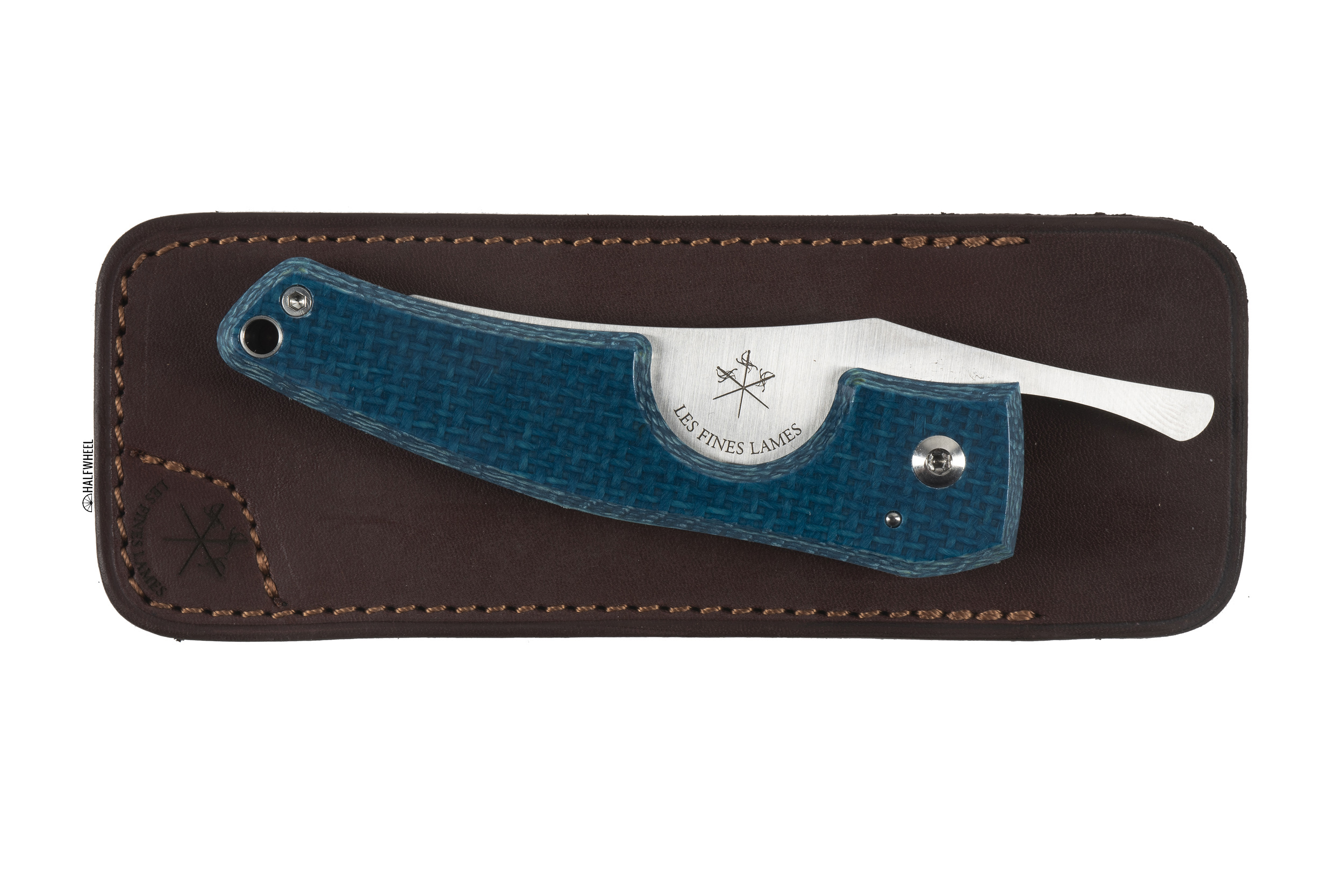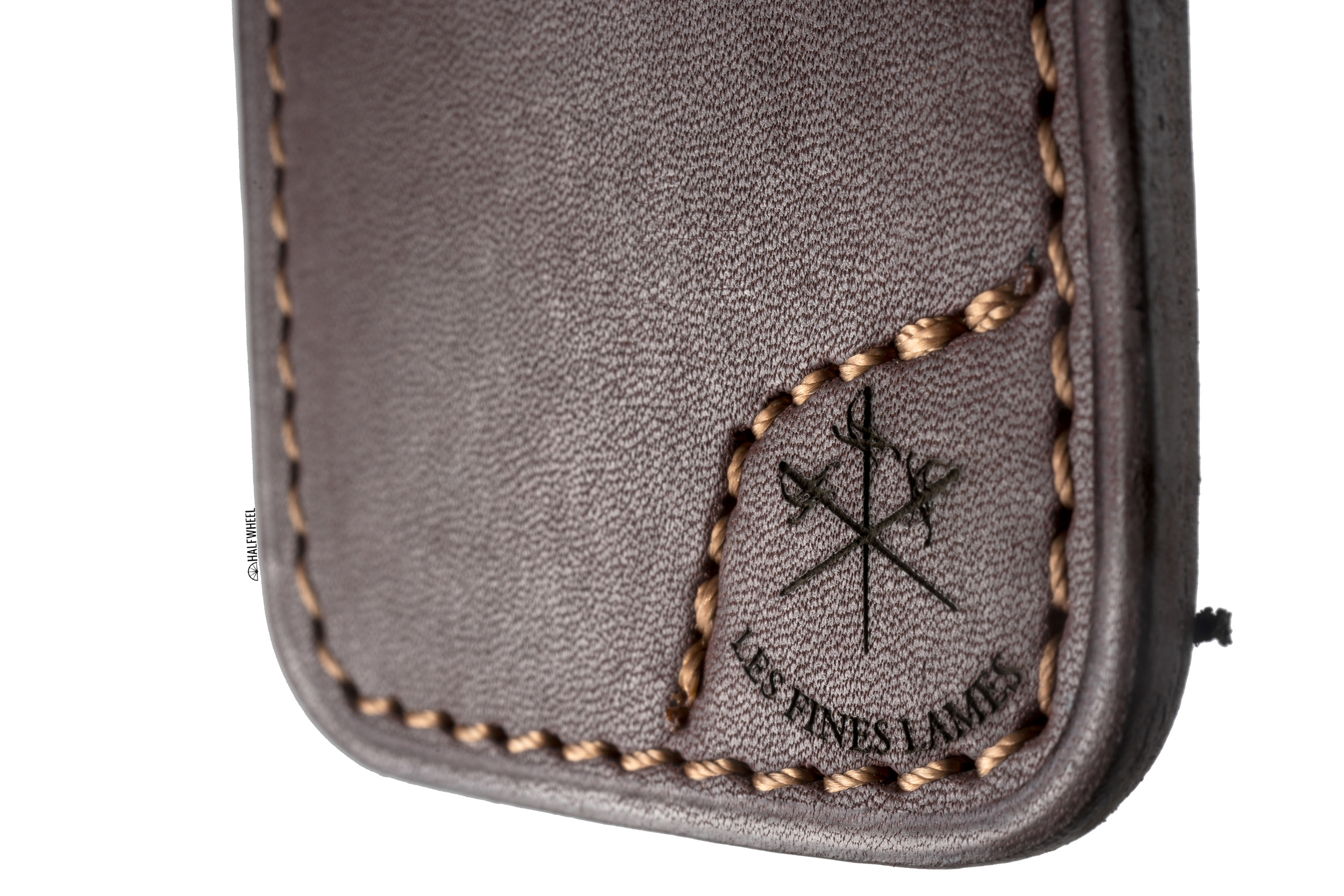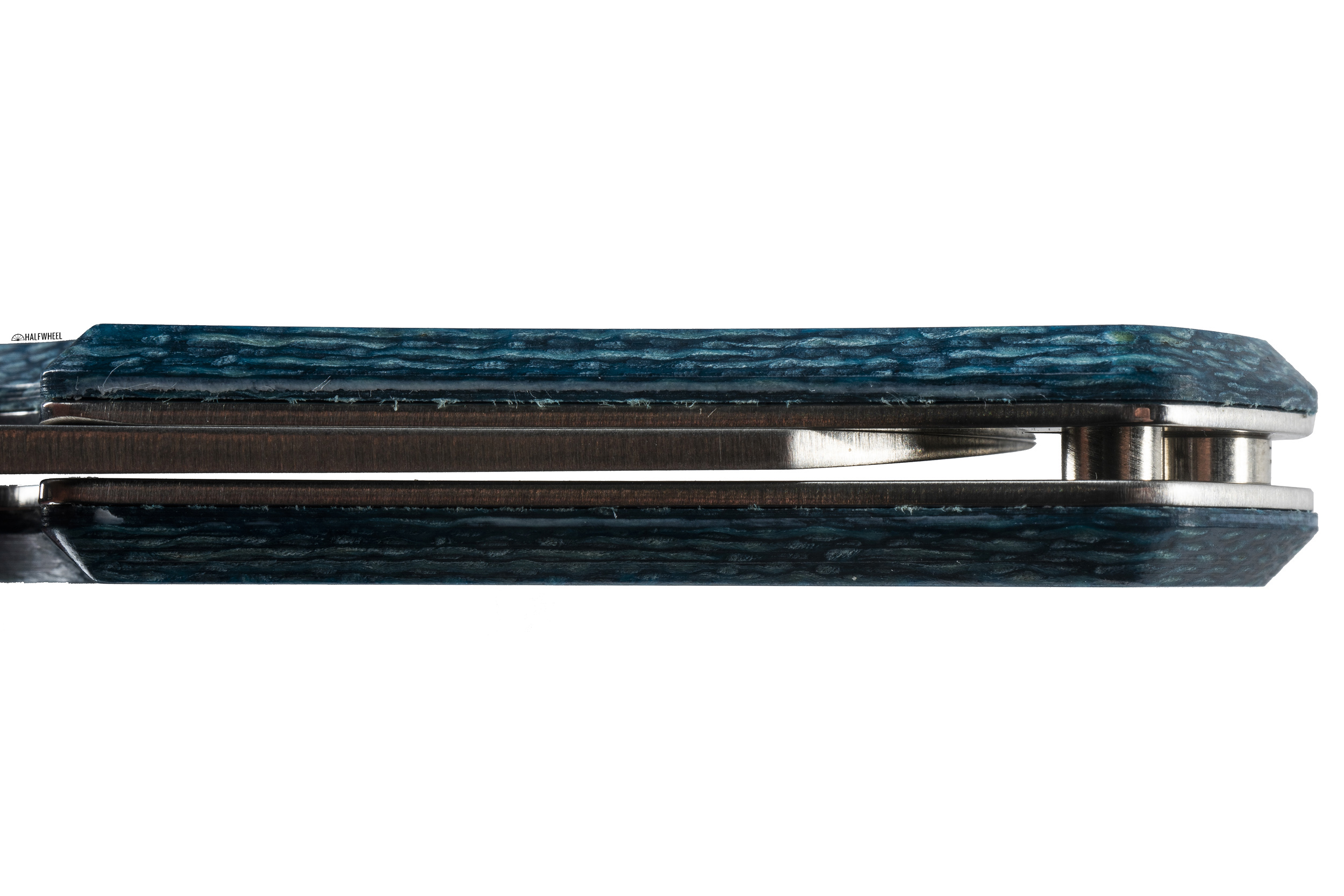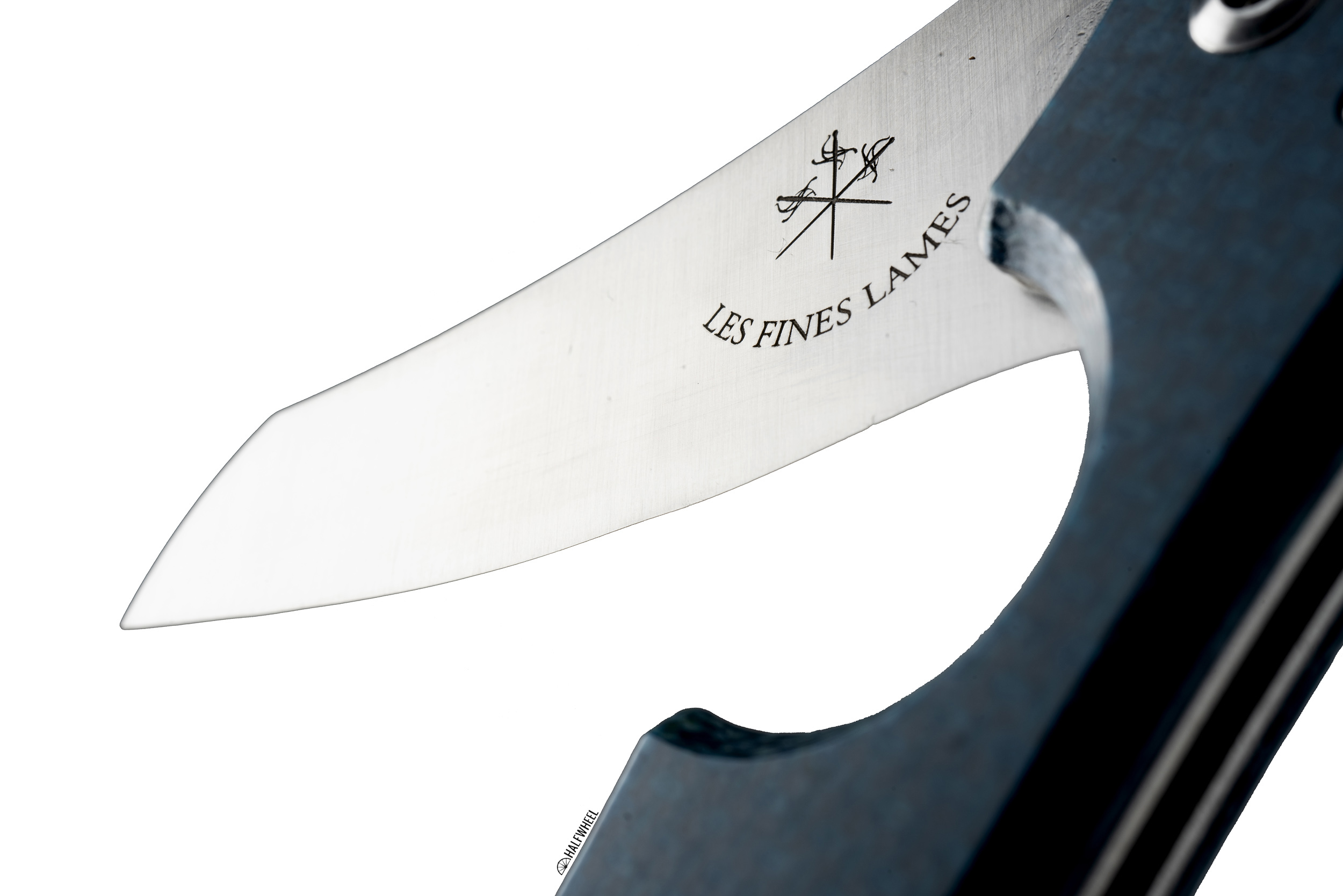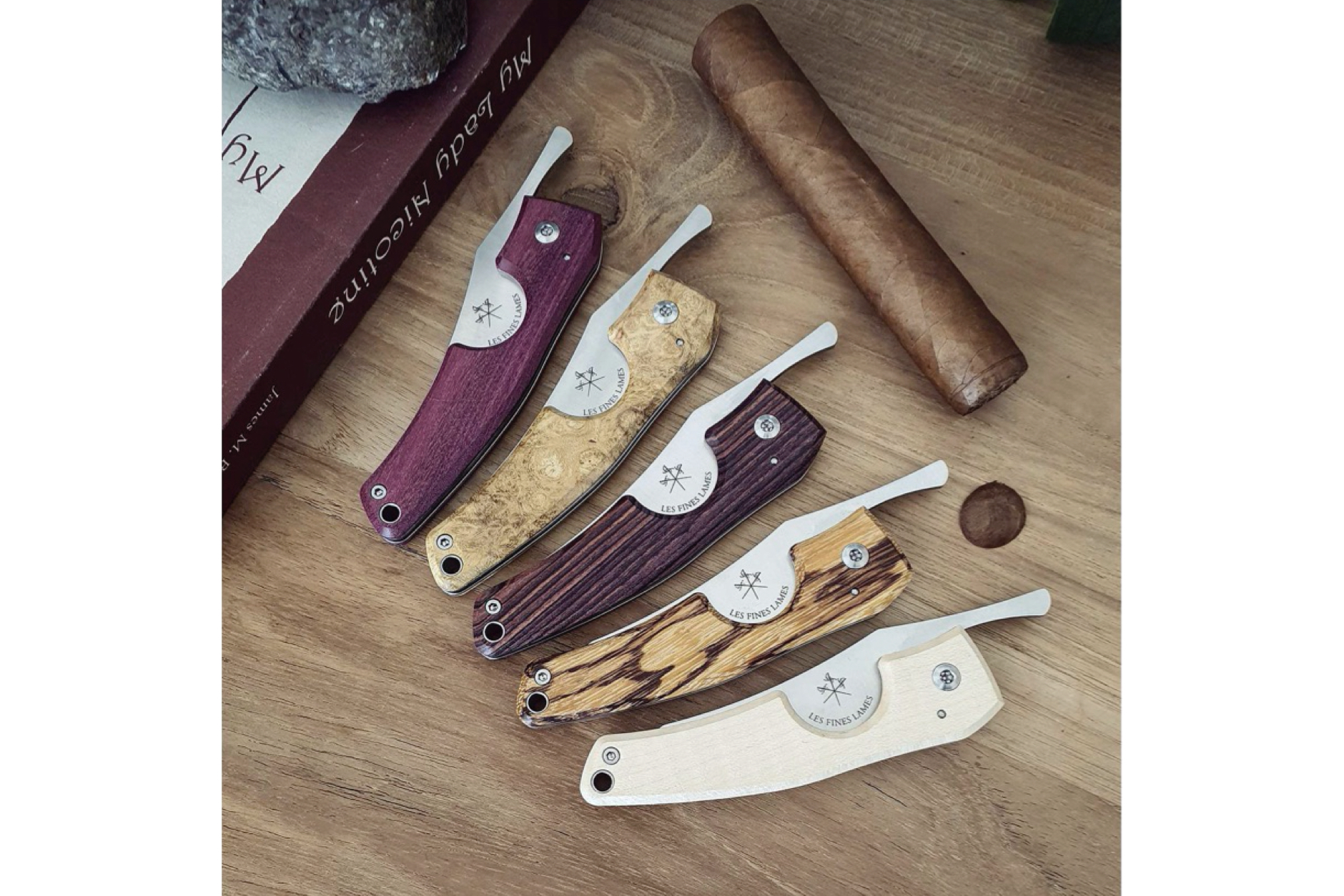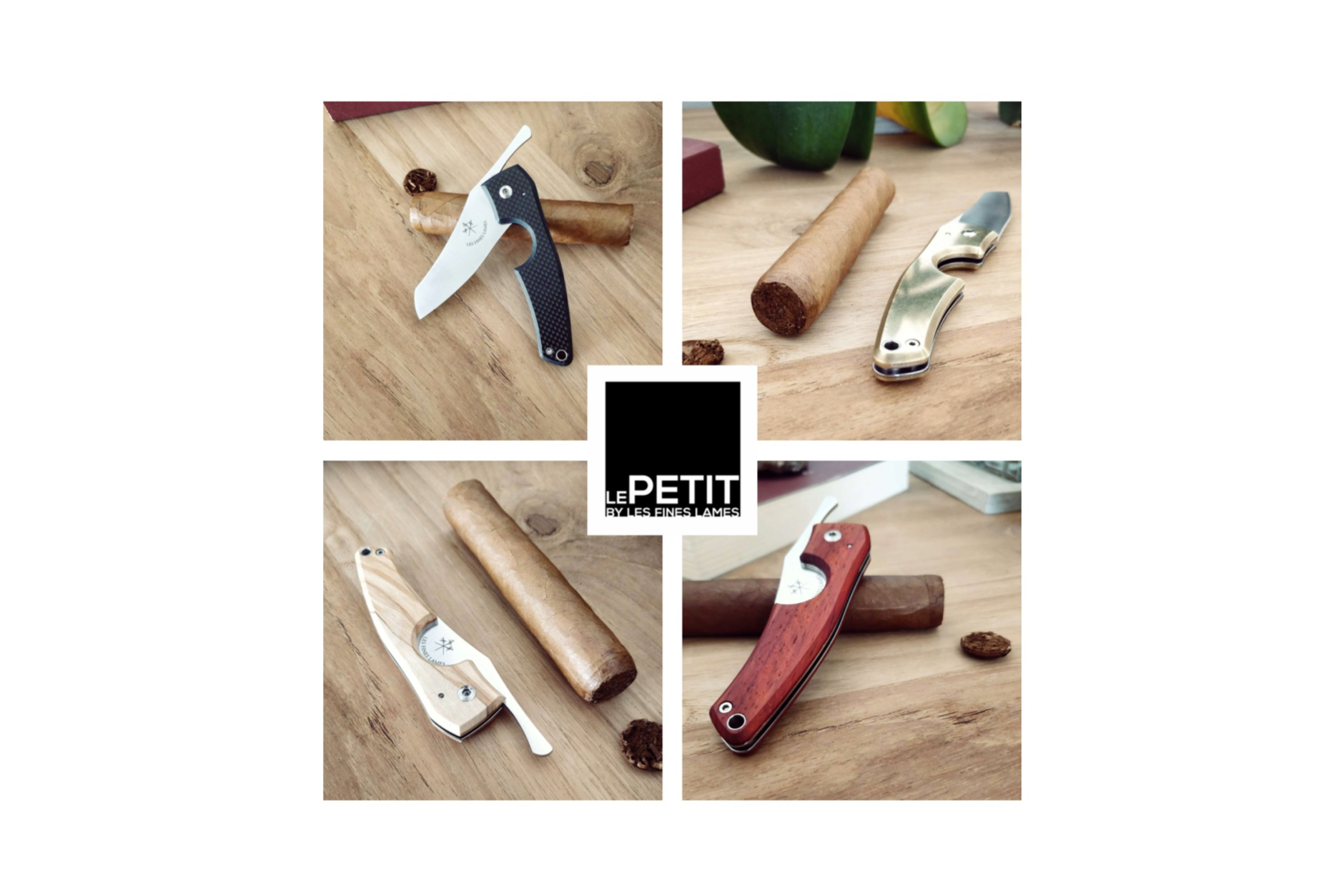In 2014, Les Fines Lames began as an Indiegogo campaign in 2014 producing piedmont-style folding knives in France. The company—which was founded by Pierre Jourdan, Yann Bouten and Gilles Bailly-Maitre and the name of which translates to the thin blade from French—marketed the product not only as a knife but also as a cigar cutter. While those original cutters were popular with some, at $350 Les Fines Lames wasn’t for everyone.
Enter the Le Petit by Les Fines Lames, which was launched as part of an Indiegogo campaign that began on Sept. 3, 2019. Although it is made with some of the same materials as the first release, the Le Petit measures only 4.53 inches long compared to the original cutter’s 5.83 inches.
WHAT IS IT?
The Le Petit is a piedmont-style folding knife made in Thiers, France. The blades are made with 14C28N stainless steel that come enclosed in exterior handles made with a variety of different materials, from micarta—which is the version I am reviewing in blue—to brass, carbon fiber and ziricote wood. According to Les Fines Lames, the 60HRC tempered hardness of the steel means the blade is “virtually impossible” to dull.
Physically, the cutter weighs in at 60 grams and measures 4.53 inches with the blade closed, while the total length with the blade open is 6.18 inches. In addition, the diameter of the cigar hole is .91 inches, meaning that you can cut a 58 ring gauge cigar completely in half, although you can cut enough of the cap off of cigars up to about 70 ring gauge to smoke them.
HOW MUCH DOES IT COST?
$149-$199 is the retail price range being charged in stores, depending on the model.
Since that time, the company has introduced a number of new limited edition versions and price points:
- Skyline Series ($159) — These 20 cutters have different skyline outlines from cities all over the world engraved on their blades, from Havana to Chicago to Taipei.
- Compass Series ($159) — Similar to the Skyline Series, these cutters have different map outlines from counties like Cuba.
- Brass Series ($199) — These three cutters are made with brass handles that feature different art and designs engraved on them.
- Classic Micarta Cutters ($149) — The base cutter is available in five different colors of exterior handles made with the composite material.
- Classic Series Cutters Level 1 ($149) — Available in a number of different woods or metals, including kingwood, curly maple and padauk.
- Classic Series Cutters Level 2 ($159) — These cutters feature more exotic materials like pear tree and field elm.
- Miscellaneous Cutters ($189) — These are made of different materials, like ziricote wood, brass and marble wood.
- Le Petit Moon ($14,180) — Three cutters made of 18K gold and adorned with two .05ct VS1 certified diamonds were launched 22.4 miles into the stratosphere to celebrate the 50th anniversary of first moon landing. The price also includes a leather sheath that is “created to your liking.”
In addition, the Indiegogo price of $119 we paid for our model included a leather sheath, whereas the retail versions are being sold sans sheath for an additional $34, although to be fair it is an extremely high-quality case for that price.
HOW DOES IT WORK?
Whether you are using it as a knife or a cigar cutter, it is opened the same way; specifically, by pushing down on a lever built onto the right end of the blade. When the blade is fully extended, that lever disappears into a position inside the base, leaving a very thin footprint. At this point you can use it as you would a normal knife, albeit one without a locking mechanism of any kind to make sure the blade stays in place at all times.
When cutting cigars, you can actually use the Le Petit in either your right or left hand, although the process for each hand changes slightly. The key is to always have the cigar facing the same way, so that the cap—i.e., the end that you are cutting off—is facing away from the blade with the beveled edge.
In practice, the process of using the cutter works like this: after opening the blade as described above, you place the now open cutter in your right hand with your thumb on the edge of the blade while the handle is cradled in your palm. This position not only means that the blade is facing away from you, but it also puts the bevelled edge facing to the right, while the Les Fines Lames logo is facing to the left.
Holding the cigar in your left hand, you then place the cigar cap into the semi-circle ledge—making sure that the smaller cap end that is being cut off is on the same side as the beveled edge of the blade as described above—and start cutting by pushing down on the edge of the blade with your thumb slowly, which pushes the blade through the cap where it sticks nicely when it comes to the end of its journey.
In order to use the cutter in your left hand, the process is the same, but the tip of the blade—with your thumb still on the edge—will now be pointed towards you and you will be holding the cigar in your right hand. Making sure the cap end that is being cut is on the same side as the beveled edge of the blade when the cigar is placed in the opening, you then push down with your thumb like before until the blade cuts through the entire cap.
As part of this review, I cut numerous cigars using the cutter in both my left and right hands to see if the results were different enough to recommend one way over the other. In fact, while certain parts of the process are different between the two—the most obvious being the amount of pressure that is needed and the location where I apply said pressure when pushing the blade down through the cap—I did not notice any significant differences in the quality of resulting cuts, regardless of which hand I held the cigar cutter in.
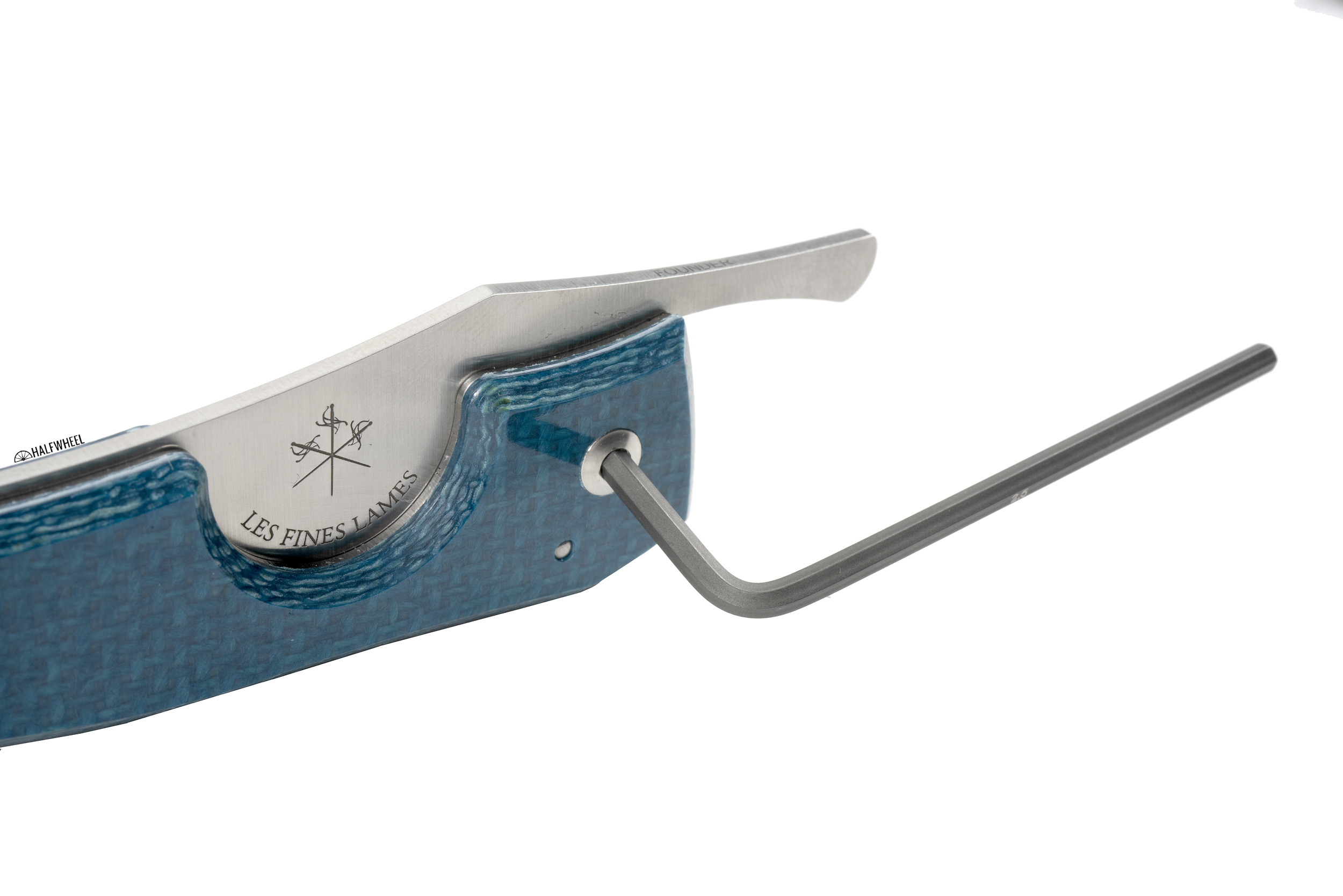
THE GOOD
- Dual Functionality — The company’s website says the cutter can be used for “opening your mail, slicing lemons for your mojito or, as we often do in France, having an aperitif with a few friends.” I am not sure that I would open my mail with this cutter—although it would work quite well for the purpose—but it is perfectly capable of being used as a knife. Having said that, I could not find anything on the website mentioning how using the cutter as anything other than a cutter would degrade the sharpness of the blades, something that is bound to happen if you did anything but cut cigars with it on a constant basis.
- It Cuts Cigars Cleanly the Vast Majority of the Time — The combination of the sharp blade and the changes to the cap opening design results in nice, clean cuts with very little damage to the wrapper of the cigar.
- The Blade Extremely Sharp — While I was careful enough to not cut myself this time, there is no doubt that the blade on this cutter is sharp, which makes sense given that this is a knife.
- You Can Actually See What You Are Cutting — Unlike the original cutter, the Le Petit features a semi-circle opening to place the cigar in, which gives you quite a bit more control over exactly where and how much of the cap you want to cut. It’s one of those things you don’t realize is important until you don’t have it.
- Smaller Footprint Makes It Much Easier to Carry Around — There were multiple times I tried carrying this cutter around in my pocket—both with and without the sheath—and there was never a point at which it became annoying in any way.
- Added Tool Allows Almost Total Control Over Blade Stiffness and Allows User to Change Out Blades — Les Fines Lames has included a hex tool that allows the user to make the blade as loose or as stiff as they want, a process that is quick and painless. In addition, the same tool can be used to remove and replace the blade of the cigar, a huge point for those wanting to customize the look of their cutters. It’s a simple hex tool, but it’s nice that it now comes in the box.
- Optional Sheath Is Much Higher Quality — The cutter is not the only product to get an upgrade, as the optional leather sheath is now made with a supple, great feeling leather instead of the thin, cheap feeling material that was originally available for the original cutter. Of note, Les Fines Lames has updated the sheath for the larger cutter.
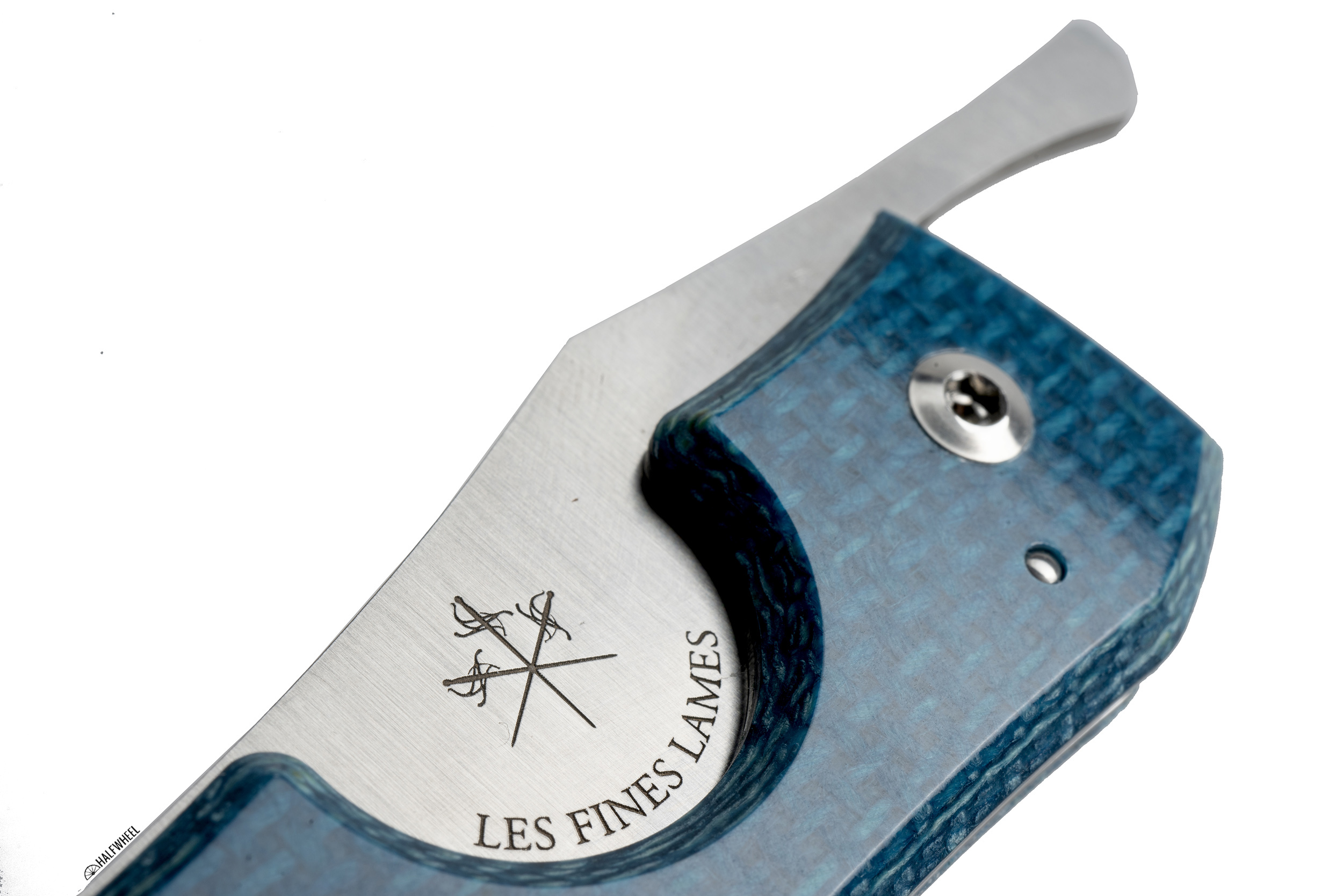
THE BAD
- Still Extremely Awkward to Use and Takes Too Long To Cut a Cigar— The opening that you insert the cigar cap into may have changed for the better, but you sill have to push open the blade put the cap in the correct spot, reposition your fingers and hand to get the optimum balance and pressure, then push the blade down through the cap—without cutting yourself—all of which takes longer than it should when you are talking about cutting a cigar.
- Price — Although it is nowhere near the $350-$500 price tag on the original Les Fines Lames, $150 is still quite a bit of money for a cigar cutter, even one that is made in France.
- Tobacco Pieces Get Stuck Inside Crevices — While not something that happened after every cut, there were times when pieces of the wrapper would get lodged in-between the two sides of the handle where the blade rests when the cutter is not open. Most times it was easy to remove; a few times it took quite a bit more time and effort.
- Optional Sheath Does Not Have Belt Loop — Considering the quality of the cutter—and the fact that there is no way to carry it other than in a sheath or loose in your pocket—I would have thought that the only sheath available from the company would have a belt loop, but that is not the case.
- You Cannot Carry It On a Plane — Perhaps less relevant for many right now, but this will need to go into checked luggage or left at home when traveling on a plane.

HOW DOES THE LE PETIT COMPARE TO THE ORIGINAL LES FINES LAMES CUTTER?
For a number of reasons, I was unimpressed with the original cutter, but the company made some significant changes with how the Le Petit looks and works that really addressed some of my larger issues that I had:
- Smaller, Lighter, Cheaper — The Le Petit is not only about half the size and half the weight of the larger cutter, it also comes in at around half the cost.
- Less Awkward to Use — Since the overall size of the Le Petit—and thus the size of the blade—is about 25 percent smaller than the original cutter, the awkwardness when both holding the cutter and while actually physically using the cutter has been reduced considerably.
- Caps Now Sit Inside An Open Half Moon Instead of a Closed Circle — Due to the fact that the circle was closed in the original cutter, you could not see exactly where the blade was going to cut through the cap. By making the location where the cap is placed a half moon shape that is open on the top, that issue has been fixed in the newer version.
- It Can Cut Larger Cigars — The diameter of the opening in the larger cutter is 23mm, meaning that you can stick a 58 ring gauge cigar completely through it and you can cut the cap off of cigars up to about 64 ring gauge. Due to the open design, the Le Petit can cut caps off of cigars up to 70 ring gauge, a huge improvement in a world where 60 ring gauge is fast becoming one of the most popular sizes purchased by consumers.
- Newer Models of Les Fines Lames Cut Better — I was able to use a newer model of the original Les Fines Lames cutter for a short time and there seemed to be a noticeable difference not only in how it felt when being used, but also in the resulting quality of cuts I ended up with, which were closer to those of the Le Petit than the first Les Fines Lames I originally reviewed. I am unsure exactly what changes the company made, but can tell you that the newer version of the original cutter was much smoother in terms of actually cutting cigars.
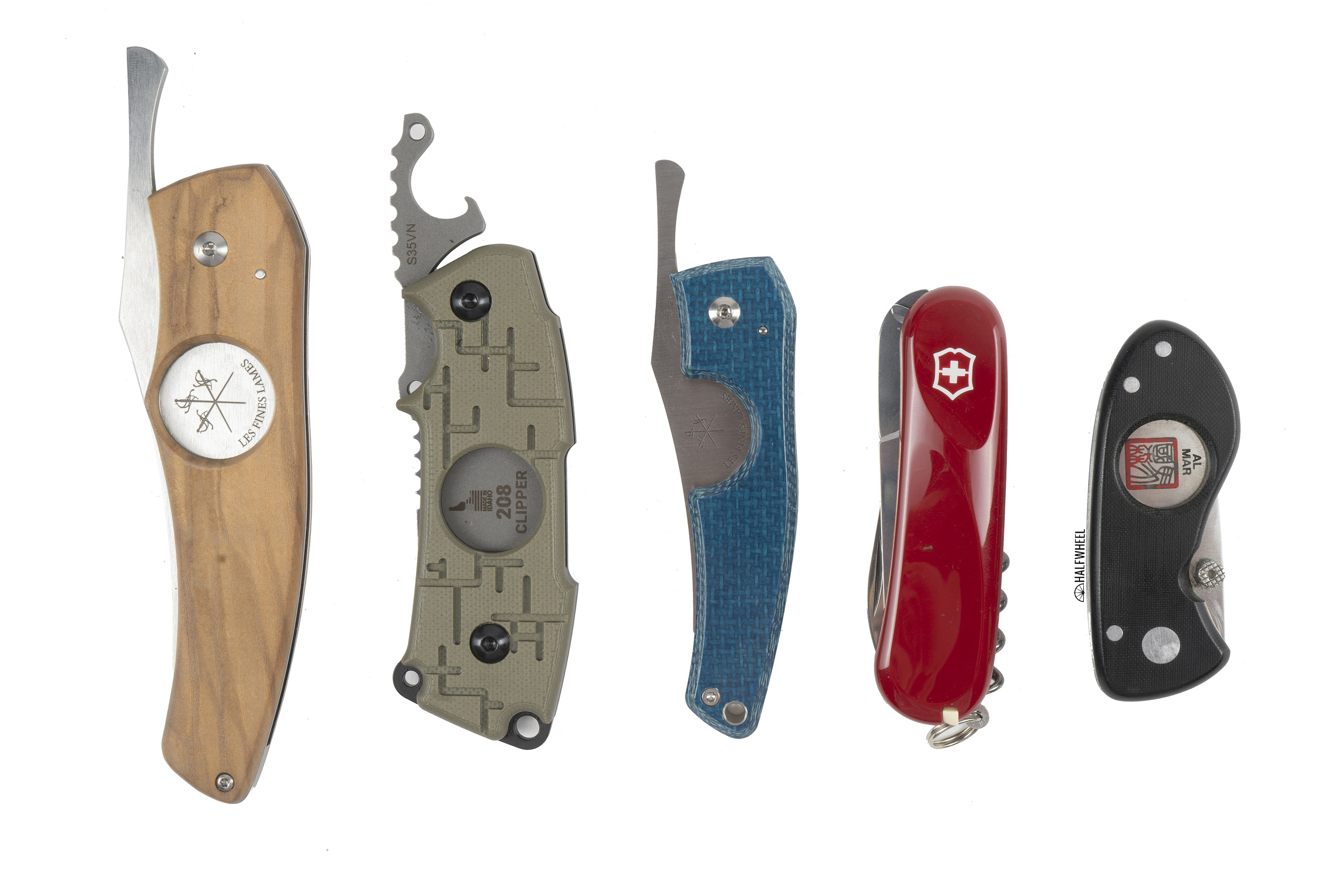
THE COMPETITION
There are a surprising number of competitors in the field of “Knives that can also be used as a cigar cutter”, with the most obvious being the original Les Fines Lames. However, that cutter is significantly more expensive at around $350, features a larger footprint and is nowhere near as good at actually cutting cigars.
Additional Competitors
- Benchmade 381 Aller Fumée ($160) — While I have not tested this yet, it comes in about the same price point while only cutting up to 58 ring gauge cigars and features an exterior made of Richlite, a material made from layering recycled paper and then applying resin.
- TOPS Knives 208 Clipper Cigar Cutter ($184) — Another cutter we have yet to review, and although it comes in at around the same price point with leather sheath included, it only cuts cigars up to about 60 ring gauge.
- Havana Al-Mar ($100) — The discontinued Havana Al-Mar also only cuts cigars up to about 50 ring gauge and is fairly difficult to find on the secondary market these days.
- Swiss Army Cigar Knife ($70) — We haven’t tested the cutting abilities of the Swiss Army knife style cigar cutter. it includes both miniature cigar scissors and a punch cutter, as well as a knife.
- XIKAR Cigar Cut Knife ($60) — It only cuts smaller ring gauge cigars and we are pretty sure it has been discontinued.
- Any Other Pocket Knife — While this gets into a question of whether you need a cigar cutter at all, pretty much any sharp knife can remove a cap cleanly by just cutting around the cap area in a circular motion. It’s not as effective for belicosos, but it’s worth pointing out that most knives will work for parejos.
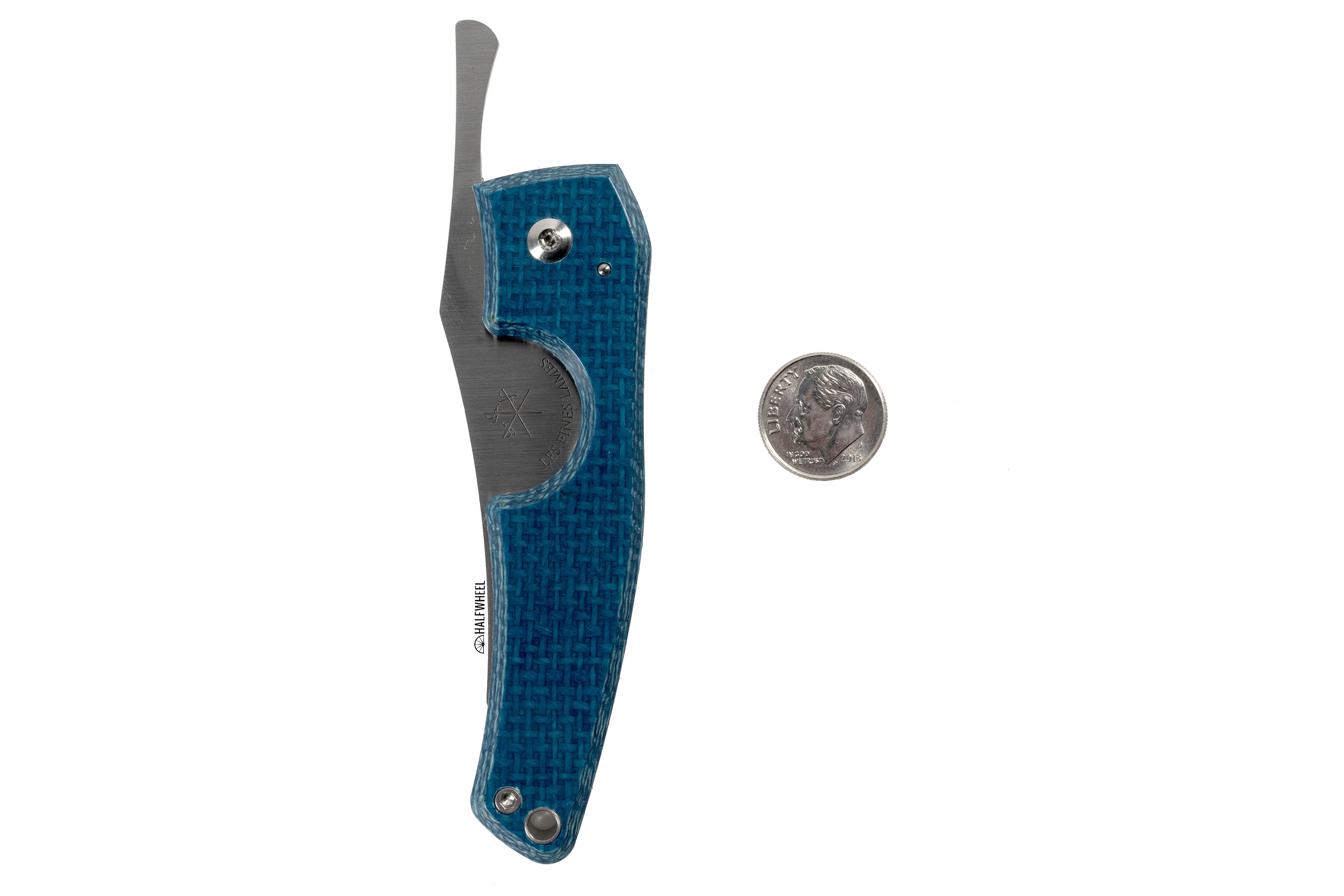
SHOULD YOU BUY IT?
If you want a cigar knife, yes.
As purely a cigar cutter, no.
I was able to get good, clean cuts on about 80 percent of the cigars I cut with the Le Petit, and about half of the issues in the remaining 20 percent were fairly minor. Given that there are cutters that will cut every cigar cleanly and with less awkwardness for a small fraction of the price, it’s a tough sell as just a cigar cutter.
Fortunately, the Le Petit is more than just a cigar cutter, it’s a cigar knife. The combination of quality build materials, sharp blade and overall design ascetic make this the best cigar knife I have tested so far, and even with the periodic issues, I can recommend it if you want to have a knife that has a specific design for cutting cigars.

